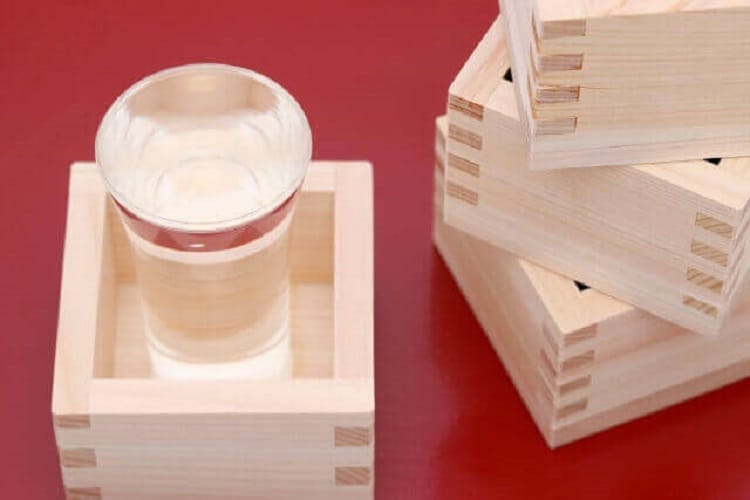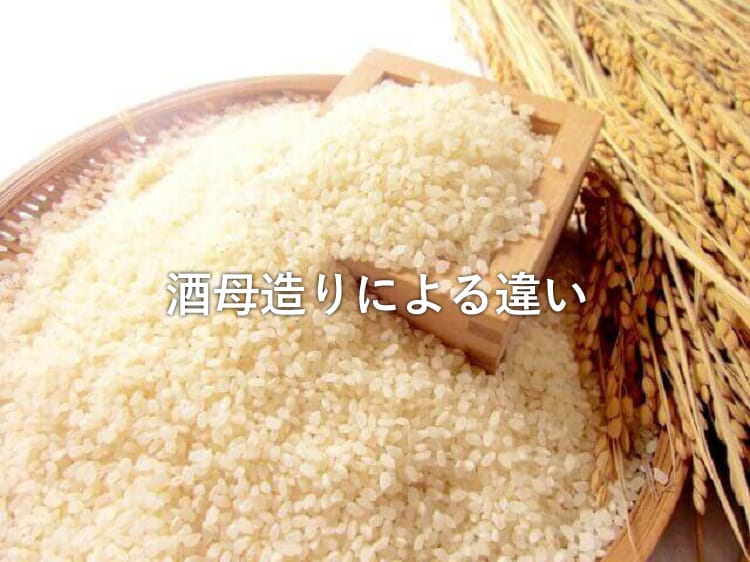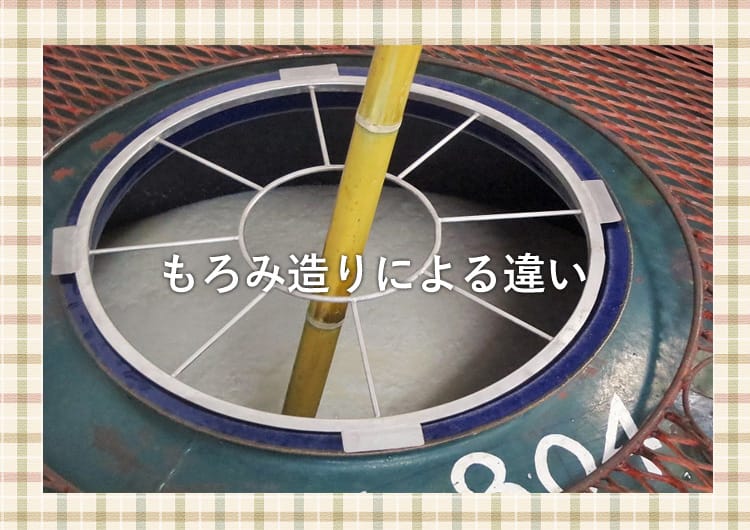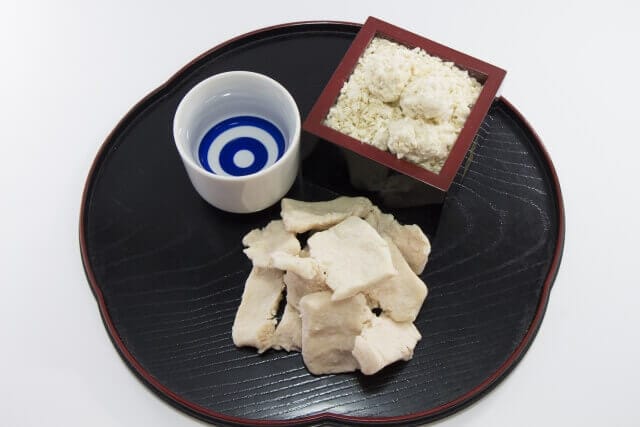
Differences due to brewing

Sake is made through a number of delicate and complex processes. One of the most important processes is sake brewing. This is because the skeleton of Japanese sake is generally decided at this stage of the sake mother.
Speaking more specifically,“Purely cultured in large quantities of excellent yeast for fermenting sake”.Contains a large amount of lactic acidIs the feature.
By creating an acidic environment,Because it can prevent the breeding of wild yeasts and bacteria that interfere with sake brewing.
Broadly divided as a method for obtaining lactic acid"Ginger-based liquor"と"Fast brewer"There are two.Obtaining lactic acid from natural lactic acid bacteria (microorganisms)"Ginger-based liquor"So, artificially adding liquid lactic acid (substance)"Fast brewer".
Furthermore, “ginger-based liquor” can be divided into “ginger” and “yama ruins” depending on whether or not the “Yama wholesale” (Yama wholesale) is used to crush and crush steamed rice.
The oldest manufacturing method among these 3 types"Ginger"Until the end of the Meiji era, this method was used exclusively for making sake mothers.
“Yama ruins” and “Hayajyu-based sake mothers” are methods developed one after another based on scientific approaches at the end of the Meiji period. It may be superior in time and cost,Almost 90% of sake currently on the market is made by “Rapid Brewery”.
So how does the taste change with these three types of sake-making? Introducing each feature.
Ginger Liquor Mother ① -Ginger-
For sake made with ginger,Strong, dark umami and deep tasteIs felt.
By using natural lactic acid bacteria, the content of lactic acid increases, so the acidity is high, and you can enjoy richness and complex depth.. It is also characterized by further increasing the deliciousness by warming it into a bowl.
Ginger-based liquor mother ②-Mountain ruins-
As with ginger, the same ginger-based liquor,Complex and rich tasteIt will be.
If you make a strong difference, ginger is cleaner and has no miscellaneous taste and finishes well.The mountain ruins tend to last a long time with a dark feel from the beginning to the endI often have the impression that
Quick brew liquor mother
Compared to ginger-based sake mothers, sake brewed by fast-brewed sake mothersLight and light typeFinished.
There is no complex taste produced by lactic acid bacteria,A refreshing and clear mouthfeel with a mild and soft liquorIs attractive.
Difference due to moromi

-Taste that changes depending on the "number of times"-
Moromi is made by putting sake mother, rice bran, steamed rice, and water into the moromi tank.
As a manufacturing procedure, first put the liquor in the tank, and then add the koji, steamed rice, and water in several batches. The number of divisions is3 times is common.
The only way to prepare for 3 timesFor safe sake brewingis. If a large amount of steamed rice or water is added all at once, the yeast and acid in the tank will dilute rapidly, increasing the risk of breeding microorganisms that can adversely affect sake brewing.
for that reason,It is required to gradually change the environment in the tank so that the yeast can grow smoothly by charging in 3 times..
Although this technique was established and established in the Edo period, despite the fact that scientific knowledge was scarce, I was just afraid of the wisdom of the predecessor who devised such a precise manufacturing method.
・ Three steps
"Three-stage preparation" to be divided into 3 timesIs called. Used in most sake,The most basic method.
As a specific method, on the 1 day, first add the brewer's mother and about 1 / 6 straw, water, and steamed rice to the tank. We measure yeast growth without doing anything ("dance").
Then, on the 3 day, the amount of rice, water and steamed rice in the amount of 2 on the first day is added (“Nakasuke”), and the remaining rice, water and steamed rice are added on the fourth day (“Rome”), Usually done in 4 days.
・ Four-stage preparation
Method of charging by adding rice bran, steamed rice, glutinous rice, etc. to moromi where the alcoholic fermentation has been settled in 3 times.
In a tank where fermentation has progressed and the alcohol content has become high due to the three-stage charging, the yeast activity is stalled.
Therefore, even if additional steamed rice or rice bran is added, the yeast can no longer decompose sugar and turn it into alcohol.The sugar remains as it is, resulting in a sweet sake..
If glutinous rice is used, the quality of the sake will increase further.
・ Those with more than 5 stages
There are not many, but "5-stage preparation" and "6-stage preparation"In some cases, the number of preparations can be increased.. What a surprise"10-stage preparation"Up to that.
If you see it at a liquor store, please try it.
-Tastes that change depending on the "raw material" to be charged-
Changing the ingredients used to make moromi can change the taste of the sake.
・ Kijoshu
When preparing moromi, sake, steamed rice, and water are added to the sake mother, but sake is used instead of water.Is called “Kijoshu”.
It is the last stage of preparationIt is common to add sake to “Rome”.The characteristic of Kijo Sake is that it has a unique thickness, is very sweet and has a rich and rich taste..
When it comes to sweetness, adding yeast sake at the end weakens the yeast that breaks down the sugar and produces alcohol,Because the sugar remains in the liquor without being broken down.
Kijo sake with a sweet tasteRecommended as dessert liquoris. You can enjoy a variety of arrangements to your liking, such as warming a little and tasting it slowly, or adding ice on the rocks or splitting with carbonated water.
You can also enjoy it with ice cream or with cakes and chocolates. This is a type of sake that can be enjoyed by those who are not familiar with Japanese sake. Perfect for those who like sweets.
・ Complete preparation
In general sake, the percentage of rice used in rice is about20%it's dark. The remaining rice is prepared as steamed rice.
But,There is also a special sake that is not just steamed rice, but only the whole rice..
This type of liquor, called “all-you-can-eat”Featuring plump sweetness reminiscent of chestnuts derived from salmon and plenty of condensed umami.
Due to the strong acidity, the sweetness is tight and you don't get the impression that it's tedious. You can enjoy various variations, such as on-the-rock, carbonated splitting, floating fruits such as strawberries, muscat, and kiwi.
It is delicious even if you drink fresh sake,The feature of “whole mashing” is also suitable for long-term aging. It's also fun to watch the alcohol change into a rich amber color while aging in the cold and dark places of your home.
One of the pioneers of all-in-one training isSouthern beauty (Ninohe, Iwate prefecture)is. Condensed and deep taste reminiscent of an old vintage luxury white wine.
I recently drank a drink called “all-you-can-eat”.Tsuchida brewery (Kawaba village, Tone-gun, Gunma prefecture) made by Tsuchida.
「麹 99%」 × 「Mountain ruins preparation」This is the world's first liquor made by combining these two key points. The sweetness and sourness that comes from the persimmon, and the rich umami and sourness produced by the mountain ruins overlap, making it a gem that you can enjoy a melon-like scent. Because it is a limited distribution product, please try it when you see it.
-Tastes that change depending on the "container"-
・ Kiso preparation
In the past, when a moromi was prepared, a wooden mallet was used exclusively. However, in modern times, enamel and stainless steel tanks are generally used.
Easy to control the action of microorganisms, and easy hygiene and maintenanceThis is the main reason.
However, this disappearing old-fashioned wooden mallet has been in the spotlight in recent years.
The number of sake breweries that are able to revive Kiso in earnest is on the rise, and the representative example is the introduction of Kiso in 2013.Shinsei Sake Brewery (Akita City, Akita Prefecture).
A warehouse dedicated to Kiso is made and several units are switched from the enamel tank every year.In the future, everything will be made into a wooden basket.It is said that.
If you use a wooden mallet,The fragrance of the wood derived from the kiso is transferred to the moromi, and the sake with a unique and refreshing scent can be created.. The taste also becomes deeper and more complex,The characteristic of the kiso preparation is that it is finished in a unique sake..
Difference by upper tank

The upper tank is the process of squeezing the finished moromi and dividing it into raw liquid sake and sake leesSay.
-Differences in taste depending on the "method" of the upper tank-
There is a big difference in the taste depending on the “method” of the upper tank, which is the tool used to squeeze moromi.
Currently most liquors areAutomatic press called “Yabut”It is squeezed using. Think of it as a machine like a giant accordion curtain, with several layers of cloth covered boards.
Almost all sake squeezed by other than automatic presses is displayed on the label of liquor bottles because of its commitment and rarity. Here are some of the typical upper tank methods.
・ Squeeze tank
A method called “tank”, a wooden container in the shape of a boat, with a sake bag filled with moromi and then squeezed under its own weight and then gently applied pressure from above..
Because it is squeezed at a pressure lower than that of an automatic press, it has a beautiful taste with less miscellaneous taste.. This method is suitable for squeezing delicate sake like Daiginjo Sake.
・ Bag hanging
How to hang a sake bag filled with moromi and collect the `` drops '' that dripping only with natural gravityis. Since no pressure is applied, it takes a lot of work and time to finish squeezing.
But if you squeeze like this,You will be able to make a wonderful sake that is transparent and full of transparency.. This is the method used for the top tanks of the highest grades such as those that are mainly exhibited at the appraisal and limited Daiginjo sake.
By the way, there are various aliases other than “bag hanging” which is a little difficult to understand.
It is called “Sake” because it collects dripping sardines, and it is also called “Douen enclosure” or “Toyotose” because it uses a dough bottle (a bottle containing 10 bottles). I'm a little confused before I get used to it.
・ Centrifuge squeezing
State-of-the-art upper tank method that squeezes not by pressure but by centrifugal forceis. Can significantly reduce the stress of moromi,Ideal and ultimate expressionIt is also said.
The original flavor of sake is fully extracted, and ginjo incense is well-confined.Way.
However, since it is a very expensive machine of 10 million yen, not many breweries have been introduced yet. For that reason, if you find alcoholic beverages that have been named “squeezing centrifuges”, why don't you try lucky and try them?
・ A method using a coarse cloth
An upper tank method of lightly rubbing moromi with a coarse clothThere is also. This is the method used when making “Nigori Sake”.
Because there is a lot of solid part of rice contained in moromi,You can feel the dark taste of rice strongly, and you can also enjoy a smooth visual and smooth touch.Liquor is ready.
~ Difference in taste depending on the timing of the upper tank ~
The “timing” of when moromi is squeezed also makes a difference in taste. Let's hold down these three.
・ Spotting
When squeezing moromi, the first part that comes out when no pressure is applied yetIs called “Rakubashiri”.
It looks a little thin and, as its name suggests,Wild wild and fresh taste and gorgeous fragrance. Alcohol content is slightly lower.
・ Introduction (Nakadori)
The part of the transparent liquid that comes out when pressure is applied little by little after spreadingIs referred to as “room arrangement”.
The balance of fragrance and taste is wonderful, and it is considered the best part of 3.. In appraisals, it seems that there are many cases where only the part of the floor plan is selected and exhibited.
It is also called “Nakagumi” or “Nakadori”.
・ Blame
The part that was squeezed with pressureIs called “blame”.
Because more ingredients come out of the moromi, compared to "Rakubashiri" and "Introduction"There are a lot of miscellaneous tastes, but it is rich and powerful.Is the feature.
It also contains the highest alcohol content in 3. There are many enthusiastic fans who are obsessed with the bruteLiquor that only collects the blame and blends it has also gained popularity in recent years..
